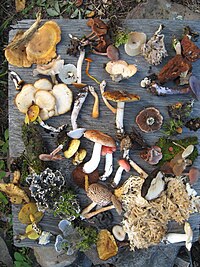
Photo from wikipedia
Unlike other macroecological principles, relationships between productivity and diversity have not been effectively tested for microbial communities. Here we describe an experiment in which the availability of resources to soil… Click to show full abstract
Unlike other macroecological principles, relationships between productivity and diversity have not been effectively tested for microbial communities. Here we describe an experiment in which the availability of resources to soil bacterial communities was manipulated in a model system, the McMurdo Dry Valleys of Antarctica. Mannitol additions were used to simulate a productivity gradient such that a response in bacterial biomass production, taxonomic diversity and functioning (e.g., enzyme activity) were induced. Resource amendment induced a positive linear response in microbial productivity (P < 0.001) but a unimodal (hump-shaped) response in microbial diversity at multiple taxonomic scales (P = 0.035). Putative oligotrophic (e.g., phyla Nitrospirae and Cyanobacteria) and copiotrophic (e.g., phylum Proteobacteria) taxa were apparent through substantial community turnover along the resource gradient. Soil enzyme activity was inversely related to bacterial biomass but positively related to diversity, suggesting the latter may be a stronger control over enzyme-mediated decomposition. The mechanisms behind this pattern are consistent with macroecological theory of a shift from environmental (e.g., stress tolerance) to biotic (e.g., competition) drivers with increasing resource availability. This evidence is among the first of its kind to document a significant unimodal productivity-diversity relationship for soil bacteria.
Journal Title: Environmental microbiology
Year Published: 2019
Link to full text (if available)
Share on Social Media: Sign Up to like & get
recommendations!